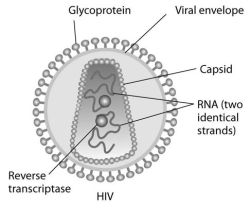Use the following information to answer the questions below.
Human immunodeficiency virus (HIV) infects cells that have both CD4 and CCR5 cell surface molecules. The viral nucleic acid molecules are enclosed in a protein capsid, and the protein capsid is itself contained inside an envelope consisting of a lipid bilayer membrane and viral glycoproteins. One hypothesis for viral entry into cells is that binding of HIV membrane glycoproteins to CD4 and CCR5 initiates fusion of the HIV membrane with the plasma membrane, releasing the viral capsid into the cytoplasm. An alternative hypothesis is that HIV gains entry into the cell via receptor-mediated endocytosis, and membrane fusion occurs in the endocytotic vesicle. To test these alternative hypotheses for HIV entry, researchers labelled the lipids on the HIV membrane with a red fluorescent dye.

-What would be observed by live-cell fluorescence microscopy if the red fluorescent lipid dye-labelled HIV membrane fuses with the target cell plasma membrane?
Definitions:
Team Development
The process of improving the effectiveness of a work group through various stages, including forming, storming, norming, performing, and adjourning.
Failure
The inability to achieve a desired goal or objective despite effort.
Storming Stage
The second stage of team development characterized by conflict and competition as group members start to express differing opinions and vie for positions.
Cross-functional
Relating to or involving multiple departments or areas of expertise within an organization, aimed at achieving a specific goal.
Q10: In the above diagram, the structure labelled
Q13: Eukaryotic sexual life cycles show tremendous variation.
Q34: When 10 000 molecules of ATP are
Q37: Which of the following statements about the
Q38: Plants transport water through their vascular system
Q52: Only once all kinetochores are attached to
Q66: Which of the following does not occur
Q79: Carotenoids are often found in foods that
Q95: During aerobic respiration, H₂O is formed. Where
Q98: The structure depicted in the above figure